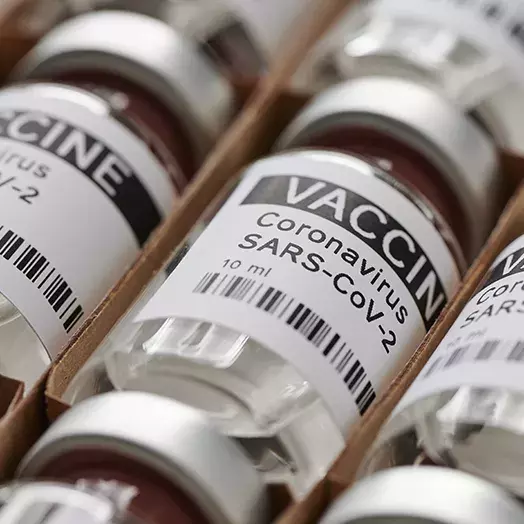Associate Professor Tinglong Dai of the Johns Hopkins Carey Business School, an expert in health care industry operations management and business analytics, examines the daunting process of administering a COVID-19 vaccine globally.

Delivering a Pandemic Vaccine Poses Extraordinary
Article Highlights
- Logistics of effort will be extraordinarily complex.
- Process of delivering vaccines is just as important as developing them.
- Rural areas lack economy of scale to invest in needed ultra-cold freezers.
Delivering a vaccine for a global pandemic that has caused nearly 1.5 million deaths and has infected more than 64 million people – as of early December 2020 – will require a logistical effort of extraordinary complexity.
In the following Q&A, Associate Professor Tinglong Dai of the Johns Hopkins Carey Business School offers insights into the process of administering COVID-19 vaccines in the United States as well as in other parts of the world. Dai is an expert in operations management and business analytics, with a focus on the health care industry.
QUESTION: We know that some vaccines must be kept at extremely cold temperatures. What are the different temperature requirements of the first three vaccine candidates? And what are the supply chain implications?
TINGLONG DAI: The three leading vaccine candidates, from Pfizer/BioNTech, Moderna, and AstraZeneca/Oxford, are very different in temperature requirements.
If you have heard people talk about a vaccine that needs to be stored at Arctic-winter temperatures, that is Pfizer’s. The Pfizer vaccine can be stored at minus-70 degrees Celsius (minus-94 degrees Fahrenheit) — plus or minus 10 degrees Celsius — for six months. Needless to say, that is a super tough temperature requirement that few hospitals or pharmacies can offer. Essentially, you would need to purchase an ultra-cold freezer, each of which can cost as much as $20,000 and hold more than 100,000 doses. So Pfizer has built a thermal shipper that can be stored at room temperature and keep vaccines ultra-cold for as long as 10 days. You can only open the shipper at most twice a day. After 10 days, you would need to add dry ice to those shippers every five days. Once you take a vaccine out of the shipper and put it into a regular refrigerator, you would have to use it within five days.
If you mentally go through how tough it is to distribute Pfizer's vaccine, you will greatly appreciate the other two vaccine candidates. The Moderna vaccine can be stored between 2 and 8 degrees Celsius (36 and 46 degrees Fahrenheit) for 30 days. That is what a regular refrigerator can offer. It can be stored for as long as six months at minus-20 degrees Celsius (minus-4 degrees Fahrenheit) in a home or medical freezer. It can also be stored at room temperature for 12 hours.
And AstraZeneca’s vaccine is yet another upgrade. Basically, it requires chilled, not cold, storage. It can be stored between 2 and 8 degrees Celsius (36 and 46 degrees Fahrenheit) for six months. This is really a very, very basic requirement. For this reason, many consider AstraZeneca’s vaccine to be the one that’s going to be widely distributed around the world.
-94 °F for 6 months
The Pfizer vaccine can be stored at minus-70 degrees Celsius (minus-94 degrees Fahrenheit) — plus or minus 10 degrees Celsius — for six months.
When a vaccine becomes available, who do you think should receive it first?
CDC’s Advisory Committee on Immunization Practices just voted on December 1 that health care workers and nursing home residents will be the first in line to receive COVID-19 vaccines. We have about 17 million health care workers and 2 million nursing home residents. So that in total gives just below 20 million people. We are expected to have about 40 million doses available by the end of December. Suppose we give the doses on a first-come-first-serve basis, we would have some doses for other groups. Next in line would be first responders, people with several underlying conditions, school teachers, inmates, and homeless people. Healthy adults, children, and others would be next. Then there are certain individuals, such as those with rare diseases, who cannot get vaccines for safety concerns. We will need to indirectly vaccinate them by vaccinating their household members.
What should policymakers do to ensure equitable distribution of COVID-19 vaccines?
The name of the endgame of the COVID-19 pandemic is not vaccine; it is vaccination. It is important to think about the institutional realities of vaccine administration. Simply giving people a certain number of vaccines does not mean it’s going to be equitable. A rural clinic may be allocated tens of thousands of doses of Pfizer vaccine, but if it cannot meet the ultra-cold temperature requirement, it would not be able to use them. Another issue is that many places simply don’t have enough health care professionals to give COVID-19 shots on a massive scale, so it’s important to ensure not only that vaccines are allocated, but also that what’s needed for vaccination is there.
What must hospitals do to prepare for the distribution of multiple brands of vaccines in the coming months?
Large and urban hospitals may consider adding some cold and ultra-cold capacity so that they will have the means to serve all vaccine brands that will become available. Small and rural hospitals should start developing and testing their information systems to allow people to sign up for vaccination and get notified about when and where to get shots. Regardless of the size and nature of a hospital, its leaders, clinicians, and supply chain professionals need to have regular war-room meetings to figure out possible logistics constraints and bottlenecks that may make it hard to get people vaccinated.
“The U.S. has the most severe pandemic in the world, so it deserves a high priority in getting vaccines. Yet, unless the rest of the world is vaccinated, we can’t assume we’ll be safe at home, either.”
Tinglong Dai, Associate Professor
What to Read Next

research
Symposium featuring Fauci explores future of vaccine and virusWill there be particular challenges in vaccinating people in rural areas of the U.S.?
The key challenge is that they don’t have the economy of scale to allow them to invest in ultra-cold freezers. Plus, each “pizza box” from Pfizer (the nickname of Pfizer's secondary packaging) has 975 doses. To use almost 1,000 doses within five days may not always be possible in rural regions. Thus, Pfizer may not be a desirable option for rural areas, unless they can figure out a way to match supply and demand efficiently, essentially creating a just-in-time type of COVID vaccine clinics. Moderna and AstraZeneca are much more forgiving in temperature requirements, but rural areas may still face other constraints, such as staffing, stable electricity networks, and PPE.
Looking beyond the U.S., what will be some of the challenges in vaccinating people in other parts of the world, especially in resource-limited regions?
Ensuring equitable vaccine allocation will be the first challenge. The U.S. has the most severe pandemic in the world, so it deserves a high priority in getting vaccines. Yet, unless the rest of the world is vaccinated, we can’t assume we’ll be safe at home, either. Many countries don’t have the functioning transportation and storage infrastructure that’s needed to do this large-scale vaccine distribution operation. To vaccinate billions of people within a matter of months is not something we are very experienced in, not to mention there is very little room for error. There is also a demand-side issue — even if you get vaccines and everything else needed for vaccination ready, people may choose not to get vaccinated. Vaccine hesitancy is not a national issue; it is a global issue. To put everything together, it’s perhaps not an overstatement to say that the COVID-19 vaccination will present one of the greatest logistics challenges in human history.


